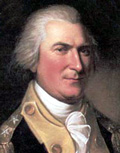| Biography: |
| Studied medicine at the University of Edinburgh; purchased an ensign's commission in the Royal American Regiment of Foot (1757); came to America with Admiral Edward Boscawen's fleet; was promoted lieutenant (1759); served under Gen. Jeffrey Amherst during the French and Indian War (1758-1760); resigned commission in 1762 and later settled in Ligonier Valley, Pennsylvania; was a surveyor of the district of Cumberland (1770) and justice of the court of quarter sessions and of common pleas; during the Revolutionary War, he accepted a commission in the Continental Army as a colonel (1776); appointed brigadier general (9 Aug 1776); was court-martialed for the retreat at the Battle of Ticonderoga (1777); was acquitted and returned to duty; appointed major general by the Congress (19 Feb 1777); became a member of the Pennsylvania council of censors (1783); was elected delegate from Pennsylvania to the Continental Congress (1785-1787); elected President of Congress [5]; was elected by the Congress (5 Oct 1787) and served as Governor of the Northwest Territory (15 Jul 1788 - 22 Nov 1802); lost to Thomas Mifflin at the election of the Governor of Pennsylvania (1790); named major general and commander-in-chief of Federal Troops (4 Mar 1791); suffered a disastrous defeat at the Battle of the Wabash fought against the Western Confederacy of American Indians (4 Nov 1791); resigned from the army at the request of George Washington; upon his removal from the office of governor, he returned to Ligonier Valley, Pennsylvania, and was engaged in the iron business. |
| Biographical sources: Biographical Directory of the United States Congress (2005); "The St. Clair Papers: The Life and Public Services of Arthur St. Clair : Soldier of the Revolutionary War, President of the Continental Congress; and Governor of the North-western Territory : with His Correspondence and Other Papers", ed. by William Henry Smith (Cincinnati: Robert Clarke & Co, 1882), 2 vols. |
| |
| [1] |
A baptismal record presumed to have been that of Arthur St. Clair (Sinclair) was found by John Henderson, author of "Caithness Family History", at the request of the Western Reserve Historical Society, Cleveland, Ohio, sent to the chief magistrate of Thurso in 1870. The St. Clair Papers: The Life and Public Services of Arthur St. Clair published at that time purported that "Arthur St. Clair was born in the town of Thurso, in Caithness, Scotland, in the year 1734. The month or day is not known." In his book, Henderson described the results of his search as follows. "In searching the Kirk Session books of Thurso, the register of baptisms does not record any Arthur Sinclair in 1734; but on 24th March 1736 there is the following entry: 'William Sinclair, merchant in town, had his son Arthur (who was born about five o'clock in the afternoon of the preceding day) baptized by the Rev. Mr. William Innes, minister here.'" ("Caithness Family History", by John Henderson (Edinburgh: David Douglas, 1884), pp. 334-335, web site) A number of reference books erroneously convert 24 Mar 1736 (Old Style) to 24 Mar 1737, overlooking the fact that Scotland unlike England changed to Circumcision Style dating on 1 Jan 1600. |
| [2] |
The St. Clair Papers, op. cit., 2:250-256. |
| [3] |
Journals of the Continental Congress, 32:11. |
| [4] |
Journals of the Continental Congress, 33:715. |
| [5] |
During the absence of St. Clair, William Grayson was elected and served as the Chairman of Congress (4 Jul 1787 - 16 Jul 1787). Journals of the Continental Congress, 32:297-349. |
|
Image: portrait of Arthur St. Clair by Charles Willson Peale (1782). |

